Folksy Remembrances of County Fairs
by Bob Brooke
QUESTION:
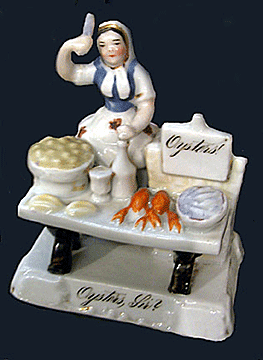 Last
year, I attended a large antiques show in York, Pennsylvania.
Among the items I found there was a large glass showcase
containing all sorts of small ceramic figurines. Among them were
about a dozen china figures posed in domestic scenes. Most had
some sort of caption painted on the front of the base. The sign
said “Fairings.” What exactly are they and where did they come
from? Last
year, I attended a large antiques show in York, Pennsylvania.
Among the items I found there was a large glass showcase
containing all sorts of small ceramic figurines. Among them were
about a dozen china figures posed in domestic scenes. Most had
some sort of caption painted on the front of the base. The sign
said “Fairings.” What exactly are they and where did they come
from?
Thanks,
Eleanor
____________________________________________________
ANSWER:
China fairings originated at English county fairs around 1860. They are
small porcelain knick-knacks that stand from three to five inches tall
and depict a variety of scenes, some humorous, others political or
domestic. They got their name because they were given away as prizes at
Victorian fairs in much the same way that stuffed animals are today.
Some were also for sale.
Fairings almost always have a base and many have a caption describing
the scene or making some point inscribed on the front of the base.
Although the majority of fairings are simply decorative, they were
occasionally made in the form of pinboxes, matchstrikers or holders for
watches or small mirrors. Some came in pairs, such as "Grandpapa and
Grandma," two separate statuettes of a small boy and girl, each dressed
in adults' clothing.
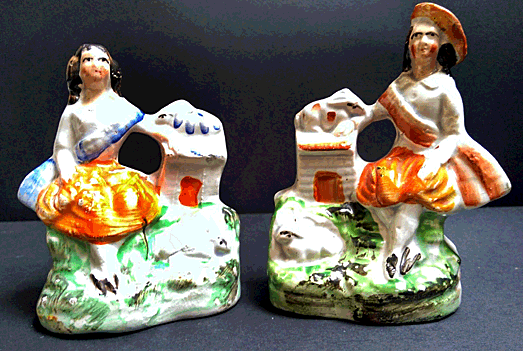
Fairings were popular among the Victorian working class from 1860 to
just after the death of Queen Victoria. Purchased for a few pence or won
as prizes, workers who often got the day off to attend the county fair,
valued and collected them as a reminder of the day at the fair. As the
century progressed, the growth of the railways and transport networks
led to increased mobility and the commercial importance of the county
fair declined. And during the later part of the century, fairings were
more likely to be sold in shops than be prizes at a fair.
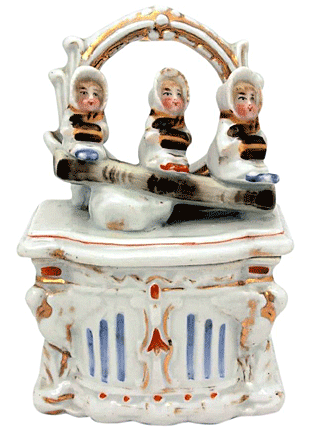 Conta
and Boehme of Possneck, Saxony, Germany, manufactured most fairings. The
company developed a mass production method that none of their
competitors could match, giving them an advantage over other firms.
Their competitors also made hollow molds, making their pieces easy to
spot. Conta
and Boehme of Possneck, Saxony, Germany, manufactured most fairings. The
company developed a mass production method that none of their
competitors could match, giving them an advantage over other firms.
Their competitors also made hollow molds, making their pieces easy to
spot.
The technologically advanced German potteries were able to produce the
small brightly colored, gilded fairings inexpensively for the mass
market. They made them of white soft-paste porcelain, assembling them
from several molds, then fired, glazed, fired them a second time, and
subsequently had painted and gilded them. Conta & Boehme made fairings
from about 1860 to 1914. Several other factories in the area also
produced fairings but theirs were of lesser quality. The production of
fairings ended with the start of World War I.
Fairing Subject Matter
The German pottery’s British agents gave them ideas for subject matter
based on courtship, marriage, everyday life, popular songs, characters
and events from the period. Fairings featured maidens, newly weds,
drunks, couples, and figures having fun. Though some had more serious
subjects, the majority were light hearted. Towards the end of fairing
production, there was a shift towards more sentimental scenes.
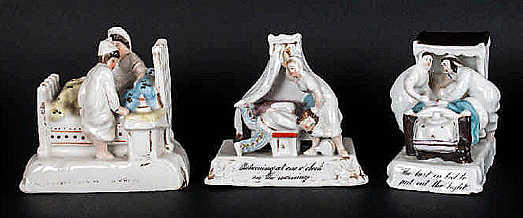
Fairing Captions
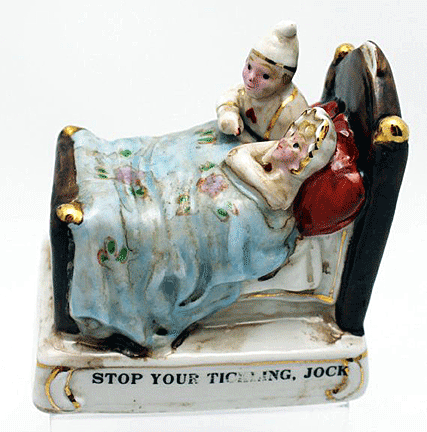 Most
fairings had captions in black or red copperplate script. The subject
matter that inspired fairings varies widely and provides an interesting
insight into the popular culture of the Victorian era. Popular songs and
music hall numbers inspire some of them, such as "Jenny Jones and Ned
Morgan" and "Champagne Charlie is my name". Others commemorate notable
people or buildings such as Ladies of Llangollen—relating to the
scandalous affair of Lady Eleanor Butler and Lady Sarah Ponsonby—or "The
Model of Laxey"—the Laxey Wheel on the Isle of Mann, the largest metal
water wheel in the world. The captions on some fairings were a little
more obscure, such as "How's business?" on one fairing and "Slack!" on
its partner, inspired by the same design on a drinking cup from the
time. Most
fairings had captions in black or red copperplate script. The subject
matter that inspired fairings varies widely and provides an interesting
insight into the popular culture of the Victorian era. Popular songs and
music hall numbers inspire some of them, such as "Jenny Jones and Ned
Morgan" and "Champagne Charlie is my name". Others commemorate notable
people or buildings such as Ladies of Llangollen—relating to the
scandalous affair of Lady Eleanor Butler and Lady Sarah Ponsonby—or "The
Model of Laxey"—the Laxey Wheel on the Isle of Mann, the largest metal
water wheel in the world. The captions on some fairings were a little
more obscure, such as "How's business?" on one fairing and "Slack!" on
its partner, inspired by the same design on a drinking cup from the
time.
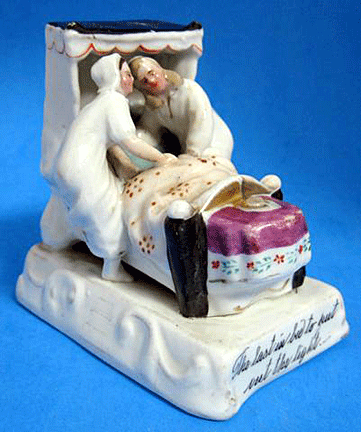 Beds
feature heavily in the domestic scenes, so much so that people once
referred to them as "bedpieces.” The captions on these fairings often
indicate a cynical attitude to marriage, for example "When a man is
married his troubles begin" on a fairing showing a man nursing a crying
baby. Another shows a man cowering from his wife with the caption "Home
from the club he fears the storm." Many, on the other hand, are simply
charming, for example "God Save the Queen," depicting a family gathered
around a piano, or "Which is prettiest?," depicting three beautiful
little girls. Beds
feature heavily in the domestic scenes, so much so that people once
referred to them as "bedpieces.” The captions on these fairings often
indicate a cynical attitude to marriage, for example "When a man is
married his troubles begin" on a fairing showing a man nursing a crying
baby. Another shows a man cowering from his wife with the caption "Home
from the club he fears the storm." Many, on the other hand, are simply
charming, for example "God Save the Queen," depicting a family gathered
around a piano, or "Which is prettiest?," depicting three beautiful
little girls.
Politics inspired other captions, such as "English neutrality 1870
Attending the sick and the wounded," commemorating the fact that Britain
didn’t become involved in the Franco-Prussian War of 1870. Others were
moralistic, such as "Seeing him home," showing a drunk being escorted
home by a spirit and the grim reaper, both dressed as undertakers.
Occasionally fairing captions descended into the downright rude, such as
"The early bird catches the worm," in which a goose pecked at what it
thought was a worm, only to cause pain to a young lad who is relieving
himself. Another one was "Review" in which two lecherous men admire a
scantily clad woman emerging from bathing.
The Seven Categories of Fairings
Collectors classify fairings into seven categories based on their
general value and rarity. Category A contains the most common fairings,
and the categories go up through B, C, D, E, F and finally X for the
rarest and most valuable fairings. Books on fairings sometimes assign
price ranges to these categories, but most collectors don’t rely on
them.
Dating Fairings
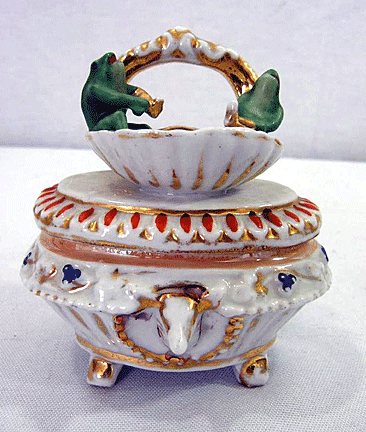 Earlier
fairings usually had more detail since they lost definition with wear
and tear on the molds and sometimes had four-digit numbers incised on
the base. Conta & Boehme, the first manufacturers, were the best. They
featured amusing mottoes in . Early Conta & Boehme pieces are unmarked,
but after the late 1870s they adopted the mark of a crooked arm holding
a dagger. Conta & Boehme began to number their pieces about the same
time as they marked them. Numbers run from 2850 to 2899 and from 3300 to
3385. At first, the numbers were scratched into the base; later they
were embossed. Any pieces that are unmarked, have a heavy Germanic or
Roman script and are stamped 'Made in Germany' on the base are not Conta
& Boehme fairings. Earlier
fairings usually had more detail since they lost definition with wear
and tear on the molds and sometimes had four-digit numbers incised on
the base. Conta & Boehme, the first manufacturers, were the best. They
featured amusing mottoes in . Early Conta & Boehme pieces are unmarked,
but after the late 1870s they adopted the mark of a crooked arm holding
a dagger. Conta & Boehme began to number their pieces about the same
time as they marked them. Numbers run from 2850 to 2899 and from 3300 to
3385. At first, the numbers were scratched into the base; later they
were embossed. Any pieces that are unmarked, have a heavy Germanic or
Roman script and are stamped 'Made in Germany' on the base are not Conta
& Boehme fairings.
However, these lack the Conta & Boehme's shield/dagger mark which the
company didn’t use until after 1845. Fairings from 1850-1860 were
generally larger than those from later on. After 1890 the colors of
Conta & Boehme fairings became brighter and more colorful. And if “Made
in Germany” appears on the bottom of a fairing, it dates from after
1891, when all ceramics had to show their country of origin.
Collecting Fairings
People collect fairings as pieces of folk art. At one time, the annual
fair was the biggest event in every country district. Fairgoers won some
as prizes, but most were sold for a few pence to adorn cottage
mantelpieces. Much of their charm lies in their very British humor,
bright, cheerful and often a little crude.
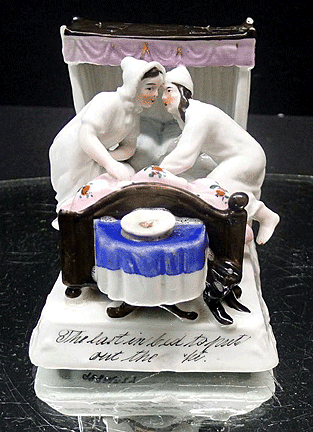 They
shared a cast of characters with music-hall skits and Edwardian saucy
postcards. Buxom matrons, hapless youths, innocent and not-so-innocent
maidens, outraged fathers, henpecked or erring husbands, nervous
newly-weds, old lechers and swaying drunkards were all grist to the
comic mill. They
shared a cast of characters with music-hall skits and Edwardian saucy
postcards. Buxom matrons, hapless youths, innocent and not-so-innocent
maidens, outraged fathers, henpecked or erring husbands, nervous
newly-weds, old lechers and swaying drunkards were all grist to the
comic mill.
The value of a fairing depends largely on its rarity. While many were
made, they were cheap objects, not meant to be treasured, so people
threw many of them away when they broke. Ironically, the charm of
fairings is in their folksy appeal, so small repairs don’t necessarily
affect their value. In fact, do-it-yourself mending may enhance it.
Genuine fairings are now keenly sought by serious collectors. In the
United Kingdom they can range in price from a few dollars for the more
common ones, such as "Last in bed to put out the light," to several
hundred dollars for the rarer ones. The most keenly sought after are the
five fairings in the Vienna series, all without captions, but
characterized by a gold band around the base.
<
Back to Readers Ask Archives
Next Article > |
